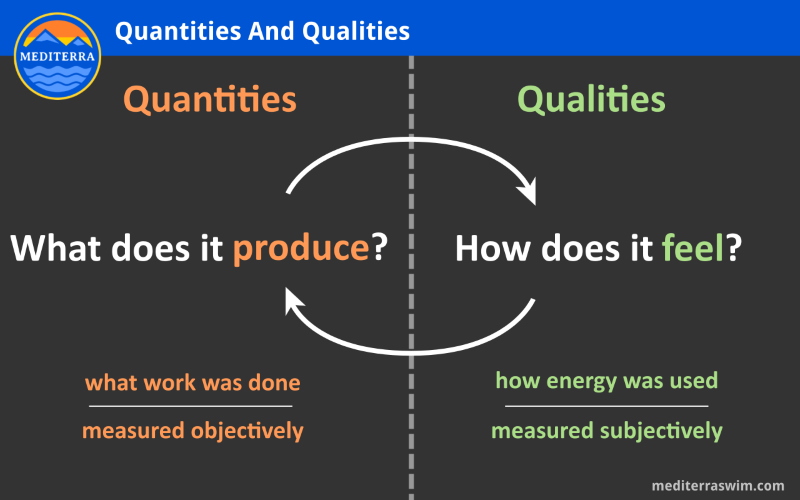by Admin Mediterra | Sep 27, 2020 | Practice Design
In order to make progress you need to measure and monitor information coming from your body and from your performance. Your progress will depend on improvements inside the body which correspond to improvements in performance (swimming easier, swimming farther, swimming faster) measured outside the body.
Measuring Quantities, Measuring Qualities
What is happening on the inside of the body (how does it feel?) – a quality – will correspond to what is happening outside the body (what does it produce?) – a quantity.

You can read more about these internal (subjective) measurements in this post on Two Essential Measurements. And these are the external (objective) measurements.

In every practice, in every swim, you will monitor those internal sensations, or what are called ‘subjective feedback’. Some of these may be assigned specifically:
On many of your practice sets you will also measure external results, or what are called ‘objective feedback’. Some of these may be assigned specifically:
- Stroke count
- Tempo
- Pace
- Distance or duration
- Amount of rest
For a simple rating system, see Simple Rating System for Your Practice Results.
by Admin Mediterra | Sep 24, 2020 | Practice Design
There is a particular way that our skill-mastery-oriented practices are designed and how progress is measured. We would like you to pay attention to this pattern and become familiar with it. Then you will be able to use the same pattern to design your own practices.
Objectives
In each section you are given a specific skill objective to work on. For those skills you are given a description of what success for this skill should look like and feel like. There may be additional instructions for the skills or focal points for What To Aim For and What To Avoid.
These assignments have both a quantity and a quality component. Each practice will assign the quantities of distance or duration (like “repeat drill 3 times”, or “Swim 3 rounds of 4x 100 whole stroke”) or have you choose them. Anything you can measure externally, like time and distance and stroke count is what we call a quantity.

And, in each section there are descriptions of the qualities you will aim to achieve – like, “keep your hips and shoulder brushing the surface for 3 seconds”, or “keep your fingers soft”. There are several qualities described in each assignment, so you have a lot to explore.
Becoming a smooth, economical swimmer – getting more work done for less expense in energy and stress – is totally dependent on the development of these qualities, for they all correspond to how you use energy in the body. You can swim faster or farther with more energy expense and stress in the body, or learn to do it with less. Our mastery-minded approach to training specializes in the latter. To this end, your success in the drills and whole stroke is measured by your qualities more than by your quantities accomplished.
The drills and whole strokes are meant to help you achieve these qualities. Developing these qualities are the point of the practices – the better the qualities are the more quantity you will be able to handle – swimming farther, faster and swim more often with eagerness. In practice you may need to decrease the challenge on your brain (complexity) to make it possible for you to succeed, or you may increase the number of repeats in order to give yourself more time to figure it out. Either way, you are aiming to achieve that quality.



